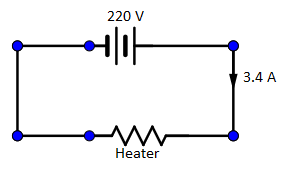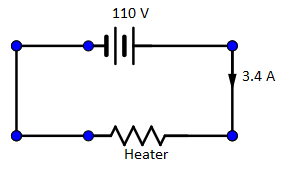Question
Question: An electric heater draws a current of \(3.4A\) from the \(220V\) supply line. What current will it d...
An electric heater draws a current of 3.4A from the 220V supply line. What current will it draw when connected to the 110V supply line?
(A) 6.8A
(B) 1.7A
(C) 13.6A
(D) 27.2A
Solution
In order to find the current during the supply line voltage, we can use the Ohm’s law which deals with the current flow. In order to find the current first we have to find the resistance that is created by current flowing through the water heater first hand.
Formula used:
By using the formula derived from Ohm’s law;
V=IR
Where V denotes the voltage, I denotes the current, R denotes the resistance.
Complete step by step solution:
Given data:
Current drawn by the electric heater, I=3.4A,
Voltage used by electric heater, V=220V,
Another voltage, V=110V

According to Ohm’s law the formula is;
V=IR
Since we have to find the resistance R ;
By rearranging the formula, we get;
R=IV
Substitute the values of voltage V , the current I;
When the voltage V=220V is;
⇒R=3.4A220V
On simplifying the above equation, we get;
⇒R=64.7Ω
Therefore, the resistance on the electric heater is R=64.7Ω when the voltage is V=220V

When the voltage on the electric heater is V=110V ;
V=IR
since we need current when V=110V
by rearranging the formula;
I=RV
Substitute the values of V=110V and R=64.7Ω ;
⇒I=64.7Ω110V
On simplification we get;
⇒I=1.7A
Therefore, the current drawn by the electric heater when it is connected to the supply line of 110V is I=1.7A.
Hence, the option (B), I=1.7A is the correct answer.
Note: We have to keep in mind that the voltage of the supply line here varies, so we have to substitute the correct voltage value for every stage of the problem. At the end each solution we definitely have to add the appropriate S.I. unit to it. The voltage is directly proportional to the current and resistance.
